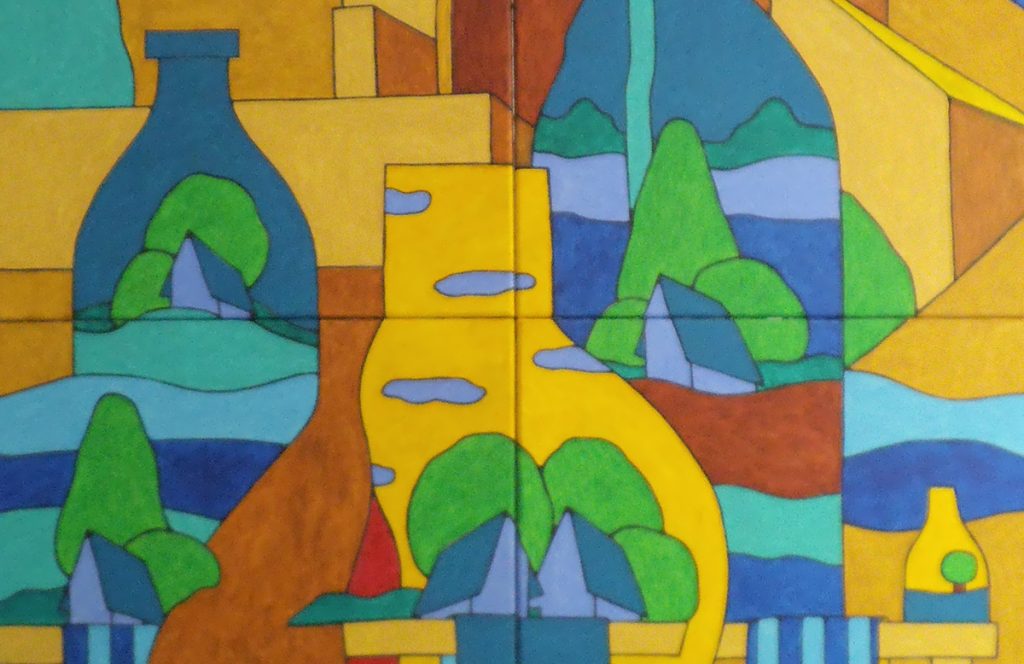Michel Marant, born August 4, 1945, in Saint-Junien, France, is a painter who translates nature and memory into vivid compositions. His career spans decades, but his focus remains steady: making visual poetry out of daily life. Trained at the National School of Decorative Arts of Limoges and officially registered with the Maison des Artistes, Marant belongs to a generation of artists who value craft as much as concept. He is referenced by AKOUN, listed on Art Price, and a member of the Academy Atlanta in the U.S., which speaks to his international recognition. Marant works across pencil, acrylic, oil, and collage, often applying his materials to canvas, paper, or cardboard. His art walks the line between modern and timeless, leaning into themes, symbols, and structured rhythm. There’s a deep calm in his compositions—an invitation to step away from the noise and look a little longer.

The painting shown here is a layered exploration of architecture, memory, and water. It features a golden-yellow abbey, perched on a hill and surrounded by deep blues, greens, and earthy reds. The structure itself feels almost like a beacon, both shelter and landmark. Its lines are softened by stylized clouds and a sky that leans toward indigo. Around it, jugs, bottles, and pots rise like monuments of their own. They aren’t placed randomly—they frame the abbey and echo its form, suggesting that vessels of water were once just as central to life as the walls of worship.
Water plays a subtle but central role in the piece. Blue bands move horizontally across the canvas—wide, calm flows that hint at rivers, fountains, and pools. These are not hyperrealistic depictions. Instead, they are symbolic, stylized. The blue lines feel like music bars or topographic lines—reminders that water is both resource and rhythm. Marant doesn’t illustrate the river; he evokes it.
The bottles and jugs, painted in flat colors and simple outlines, speak to a tradition of collecting and storing. In this town—suggested by the small houses scattered throughout the canvas—these vessels might have been used for daily rituals. There’s something almost ceremonial about their size and placement here, suggesting reverence. Their outlines double as architectural forms, blurring the line between object and environment.
The painting’s composition is structured but not stiff. The vertical lines of the abbey and bottles are broken by the soft, curving shapes of hills, trees, and water. Green triangles hint at foliage or topiary. Tiny rooftops peek out from the bottom corners, creating a sense of a village tucked into the hillside. There’s warmth in the yellow and ochre tones, balanced by cool shadows of blue and green. The color palette is bold but harmonious—nothing screams for attention, yet every corner feels intentional.
Marant’s use of line is key to how this painting functions. Black outlines define every element, giving the work a stained-glass quality. That approach flattens perspective but enhances clarity. It’s easy to follow the painting’s internal rhythm, like reading a visual map. Your eyes move from hill to bottle to building to stream, and then back again. The symmetry is loose but present.
Emotionally, the work feels reflective. It doesn’t push drama; it invites quiet curiosity. This isn’t just a picture of an abbey. It’s a memoryscape, where function and feeling mix. Water becomes more than hydration—it’s history. The vessels become more than storage—they are icons. The abbey becomes more than a structure—it’s a symbol of place, community, and continuity.
Marant’s style can loosely be connected to Art Nouveau and certain strands of contemporary European illustration. But this work stands on its own terms. It doesn’t try to dazzle with detail. Instead, it strips things down to essence. It reminds us how much story you can tell with just shape, color, and rhythm.
There’s a quiet kind of care in this painting—each line deliberate, each color chosen. It’s not nostalgic, but it carries memory. Not loud, but deeply resonant. Like the town it depicts, it feels lived in. And like the water it reveres, it keeps moving—gently, endlessly, through time.


